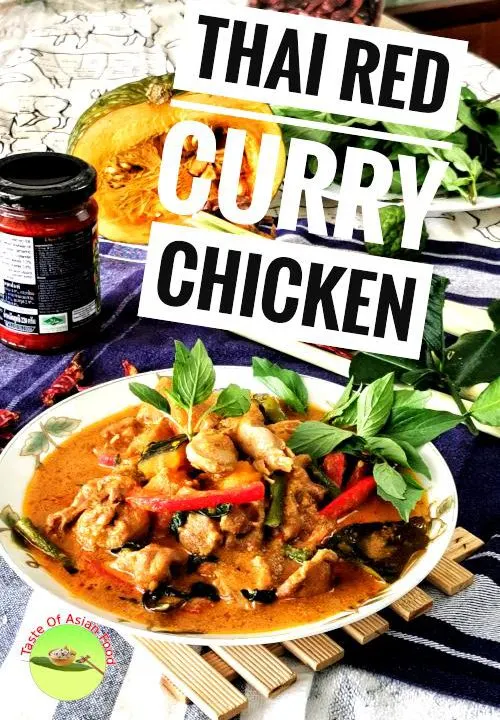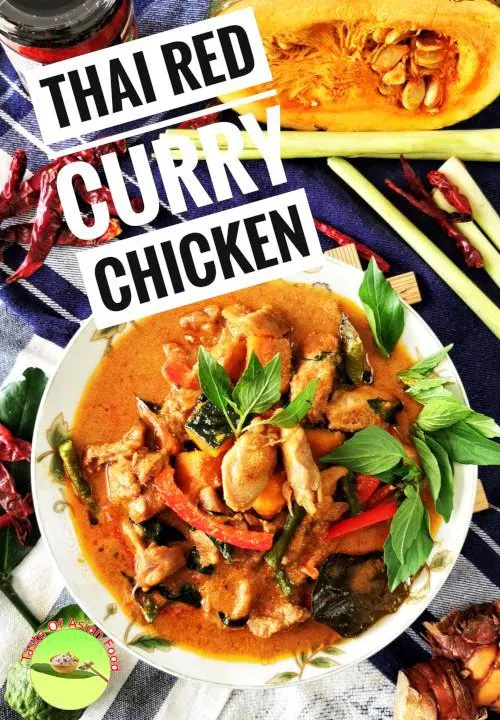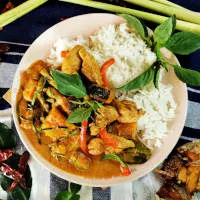What could be better than savoring Thai red chicken curry, the authentic street food with spices attacking all your senses?
Thai red curry is prepared with a blend of unique spices. The intense flavor of galangal, lemongrass, kaffir lime, dried chili, fish sauce, shrimp paste, coconut cream, and basil leaves are concentrated into a thick gravy. I feel sorry for you if you miss out on Thai red chicken curry, one of the best Thai food I ever have.
This recipe will show you how to make it at home, both from scratch or use the store-bought red curry paste.
Let’s get into the details right now.

Note: This post may contain affiliate links. Please read my privacy policy for more info. I may receive commissions for purchases made through links in this post. As an Amazon Associate, I earn from qualifying purchases.
How to make Thai red chicken curry
1. Make the Thai red curry paste from scratch
Most of the flavor of the Thai red curry comes from the curry paste. Therefore, if you want to cook the best red curry, you should prepare it with fresh curry paste made from scratch.
Making the Thai red curry paste is relatively easy. It is just a matter of putting all the ingredients into the electric grinder and blends them into a paste. However, it is a challenge to get all the ingredients if you are not living in Thailand or the adjacent countries.
a. Ingredients for Thai red curry paste
Here is a list of common ingredients which you need when making the paste. First, lets’ take a look at some of the key ingredients.
Lemongrass
Lemongrass has a unique flavor and aroma, which is vastly different from lemons. Therefore, lemon is not a substitute for lemongrass.
I can get lemongrass in any grocery store and market in Malaysia. For your information, Malaysia is the neighboring country of Thailand, and lemongrass is also a significant component of Malaysian-style curry. You may find them at the frozen section if you live outside Asia.
The edible part of lemongrass is the off whites bulb section. First, slice off about 1cm from the root and also cut off the leafy sheath at the other end. Next, peel off the dried-out layer, then bash with the back of the knife and cut it into short sections.
Dried red chili
The flavor of curries depends on the type of chilies in the recipe. For example, dried red chilies are often used to make Thai red curry paste, and Thai green curry is prepared with fresh green chilies.
We also made the Malaysian-style chicken curry in our restaurant, which involves only fresh red chilies, and it has a different flavor from the Thai curries.
Therefore, it is essential to use dried red chilies to prepare Thai red curry to get the authentic flavor.
The number of chilies you need
I use about twelve dried chilies (about 2 inches long each) to make the red chili paste, which yields about 175g. You can adjust the amount to suit your tastebuds. If you can’t take the heat like the Thai’s, cut the dried chilies in half, shake out all the seeds, and discard them. It is better to remove the seeds than to reduce the number of chilies, as they provide a substantial amount of flavor to the curry.
Dried chilies might be difficult to blend, so it is best to soak them in water until soft (about fifteen minutes in hot water should be enough) before adding them to the food processor.
Galangal
Both ginger and galangal look similar, but the taste is different. In short, they cannot be used interchangeably.
Galangal is much harder than ginger. The skin is thicker and cannot be eaten. You need to cut off the skin, slice or dice the flesh into small pieces before adding it to the grinder. Otherwise, the grinder will not be able to process it into a paste.
There is frozen galangal sold outside Asia. Fortunately, we can get fresh galangal at any markets and grocery stores in Malaysia, as it is a significant component of Malaysian cooking.
Kaffir lime
The rind and leaves of kaffir lime are used in Thai and other Southeast Asian cooking. Both of them have an intense citrusy aroma. I use the rind of one kaffir lime in this recipe. If you can’t get kaffir lime, you can substitute it with a few kaffir lime leaves.
Kaffir lime is also an essential ingredient for another Sothern Thai curry called Massaman curry, which you can get the recipe here.
Palm sugar
Palm sugar is derived from the sap of palm trees. It tastes more like molasses than white sugar. You can easily substitute it with brown sugar with a 1:1 ratio.
Thai shrimp paste
Thai shrimp paste is made from fresh shrimp and then fermented with salt. It has a strong smell that may put off certain people, but it tastes excellent once mixed with other components. The Malaysian shrimp paste (belacan) is a good substitute for Thai shrimp paste. You can find the Kapitan chicken recipe on this blog, which uses belacan. The taste is quite close to the Thai red curry.
b. How to prepare Thai red curry paste
Once you have gathered all the ingredients required (please refer to the curry paste recipe below), just blend the ingredients into a smooth paste with an electric grinder.
You need to cut the large chunks of ingredients into small pieces. Otherwise, it is hard to blend them finely.
Making the curry paste allows you to decide the amount of each ingredient. For example, you can use fewer chilies (and remove the seeds) to make it less hot and maintain the total amount of other ingredients to get the maximum flavor. You may also omit the shrimp paste if you intend to make a vegetarian curry. Finally, you have complete control of the recipe.
2. Use the store-bought Thai red curry paste
If you are not so fuzzy about cooking or want to take a shorter route to make the curry, head to the grocery store to ask for Thai red curry paste.
The quality of store-bought curry paste can vary from brand to brand. You should pick one that suits your need (the volume and the ingredients), but the most important thing is the freshness. The flavor of curry paste close to the expiring date may have deteriorated.
You should check whether it contains salt, as you may need to adjust the amount of salt and fish sauce in the Thai red curry recipe.
3. Use chicken thigh meat (and other options)
Boneless and skinless chicken is the most common meat to use in Thai red curry. You can use breast meat but should cook over low heat to prevent it from turning tough. I like to use chicken thigh meat because it has more flavor and does not become tough and dry if overcooked.
Besides the chicken, beef and shrimp are also suitable for cooking red curry. Of course, the time to cook them is shorter than chicken.
Firm tofu is an option as the source of protein if you want to prepare a vegetarian dish. Tofu is added to the curry in the last step to avoid them from breaking during cooking. I have another recipe for vegetarian red curry, which will be uploaded soon.
4. Pick the accompanying vegetables that you like
I like to use kabocha for this recipe because it has a sweet taste, does not need to peel the skin, and thickens the curry.
Long beans and red bell peppers are also included to give some texture and colors to the curry.
It takes about fifteen minutes to cook the kabocha until soft. Try not to overcook the kabocha as it will disintegrate and become mushy. Therefore, I will add the kabocha ten minutes before the intended cooking time for the chicken. Long beans take about five to eight minutes to turn soft, and bell peppers should add last to preserve the crunchiness.
Other suitable vegetables are winter melon, eggplants, and bamboo shoots.
Basil leaves are added in the final stage. Once you throw the basil leaves into the curry, you can turn off the heat as the residue heat will wilt the leaves quickly.

5. Is coconut oil essential?
Traditionally coconut oil is used for cooking curry paste. Add a quarter to half a cup of coconut cream to the pan and boil it until all the liquid is evaporated. What is left in the pan is the coconut oil for cooking the chili paste.
While this is workable with fresh coconut cream, it may not work well if you use the canned coconut cream as the oil may not separate. However, you can use any vegetable oil to saute the curry paste and add all the coconut cream to the curry later since there is no noticeable difference.
There is some confusion between coconut milk and cream, as both phrases are used interchangeably at certain places. If you get coconut cream in a tetra pack or can, look for one with a fat content between 20-25% (check the packaging). Those coconut milk for drinking has a much lower fat content, which is not suitable for cooking curry.
6. Steps to cook the Thai red chicken curry
Here are the steps on how to cook the Thai red curry with chicken and kabocha.
- Heat half a cup of freshly pressed coconut cream in a pan. Cook over low heat until all the liquid has evaporated, and only the coconut oil is left in the pan.
- Add the red curry paste to the coconut oil in the pan. Saute until aromatic.
- Add the marinated chicken and mix well with the curry paste.
- Pour another half a cup of coconut cream into the pan. Bring it to a boil
- Include the kaffir lime leaves, fish sauce, and palm sugar.
- Let it simmer for about fifteen minutes, or until the chicken is cooked, and absorb the flavor of the spices.
- Add half a cup of water if it is too thick.
- Put the kabocha into the pan to cook for ten minutes.
- Add the long bean and continue to cook until the kabocha and long beans are soft.
- When it is about to ready, do a taste test to adjust the flavor with fish sauce, sugar, and curry paste.
- Add the bell peppers and basil leaves. Turn off the heat and mix well until the basil leaves are wilted.
- Garnish with some finely shredded kaffir lime leaves and serve with steamed rice or noodles.
Other related Thai recipes
If you like this recipe, you should also try some other Thai recipes on this blog. Here are my picks:
Thai basil beef is a perfect one-pot meal, as it can make it in less than 30 minutes and satisfy almost every palate. It can be served as noodles or rice top with a fried egg. Give it a try.
Do you like noodles? Pad see ew is the Thai street food that is easy to prepare, as there are only a few ingredients required, and the cooking is simple. The main ingredients are soy sauce and Chinese broccoli. Don’t miss out on this authentic Thai flavor.
Pandan leaf chicken is one of the best specialty dishes in Thailand. The chicken is moist, tender, infused with a refreshing pandan aroma, and encased in leaf packets.

Thai red chicken curry - How to make the best Thai curry from scratch
Thai red chicken curry is the best Thai curry, season with kaffir lime and fish sauce to get the authentic flavor. The curry paste is made from scratch.
Ingredients
Ingredients (for the curry paste)
- 30g lemongrass (weight is for white section only, about 2 stalks)
- 12 g dried red chili (12 pieces of 2-inch length chilies)
- 30g garlic (1 small bulb)
- 2 tbsp vegetable oil
- 30g (2 small shallots)
- 15g (galangal)
- 1 tsp salt
- 1 coriander root
- 1 kaffir lime (use peel only, or substitute with 4 kaffir lime leaves)
- 1 tsp cumin powder
- 1 tsp coriander powder
- 1/2 tsp white peppercorns
- 1 tsp Thai shrimp paste (or replace with belacan)
- 2 tbsp water
Ingredients (for the curry)
- 1 cup coconut cream
- 300g kabocha squash, bite-sized pieces
- 500g chicken thigh, boneless, skinless, 1.5-inch cubes
- 120g red curry paste (homemade or store-bought)
- 1/2 cup water
- 3 tbsp fish sauce
- 2 kaffir lime leaves
- A tbsp palm sugar
- 1 cup Thai basil
- 50g Red bell pepper (1/3 red pepper, julienned)
- 50g long bean, cut into 1-inch length
- Additional lime and basil leaves to garnish
Instructions
For the curry paste
- Cut and discard the root section and green section of the lemongrass. Next, remove the fibrous outer layer of the lemongrass, then bash with the back of the knife to flatten it. Finally, cut it crosswise the short sections.
- Cut the dried chilies into short pieces. Remove the seeds. Soak the dried chilies in water until soft, which takes at least fifteen minutes to soften them.
- Remove the skin of the galangal that is tough, then cut the galangal into small pieces.
- Peel off the skin of a kaffir lime. Give the skin a few rough chops,
- Place all the ingredients in an electric grinder, then process it into a fine paste.
For the curry
- Heat half a cup of freshly pressed coconut milk in a pan.
- Cook over low heat until all the liquid has evaporated.
- Add the 120g (4 oz) of red curry paste to the remaining coconut oil in the pan. Saute until aromatic.
- Marinate the chicken with 1 tbsp of fish sauce for 30 minutes, then put the chicken into the pan and mix well with the curry paste.
- Pour another half a cup of coconut milk into the pan. Bring it to a boil
- Include the kaffir lime leaves, fish sauce, and palm sugar.
- Let it simmer for about fifteen minutes.
- Add half a cup of water if it is too thick.
- Add the kabocha to cook for ten minutes.
- Add the long bean and continue to cook until the kabocha and long beans are soft.
- Do a taste test to adjust the flavor.
- Add the bell peppers and basil leaves. Turn off the heat.
- Garnish with some finely shredded kaffir lime leaves.
Recommended Products
As an Amazon Associate and member of other affiliate programs, I earn from qualifying purchases.
-
 Ninja Professional 72 Oz Countertop Blender with 1000-Watt Base and Total Crushing Technology for Smoothies, Ice and Frozen Fruit (BL610), Black
Ninja Professional 72 Oz Countertop Blender with 1000-Watt Base and Total Crushing Technology for Smoothies, Ice and Frozen Fruit (BL610), Black -
 Thai Shrimp Paste, 3.10 Ounce
Thai Shrimp Paste, 3.10 Ounce -
 Mae Ploy Red Curry Paste, Authentic Thai Red Curry Paste For Thai Curries And Other Dishes, Aromatic Blend Of Herbs, Spices And Shrimp Paste, No MSG, Preservatives Or Artificial Coloring (14oz Tub)
Mae Ploy Red Curry Paste, Authentic Thai Red Curry Paste For Thai Curries And Other Dishes, Aromatic Blend Of Herbs, Spices And Shrimp Paste, No MSG, Preservatives Or Artificial Coloring (14oz Tub) -
 MICHELANGELO Nonstick Frying Pan Stone with Ultra Nonstick Granite Coating, 10 Inch Frying Pan with Lid, Nonstick Skillet Pfoa Free, Non toxic Rock Pan, Induction Compatible -10 inch
MICHELANGELO Nonstick Frying Pan Stone with Ultra Nonstick Granite Coating, 10 Inch Frying Pan with Lid, Nonstick Skillet Pfoa Free, Non toxic Rock Pan, Induction Compatible -10 inch
Nutrition Information:
Yield: 3 Serving Size: 1Amount Per Serving: Calories: 694Total Fat: 34gSaturated Fat: 14gTrans Fat: 0gUnsaturated Fat: 19gCholesterol: 218mgSodium: 3764mgCarbohydrates: 49gFiber: 8gSugar: 15gProtein: 55g
This data was provided and calculated by Nutritionix on 6/25/2021

Thai Green Curry recipe - How to prepare the authentic way
Tuesday 6th of August 2024
[…] Here is the recipe if you have tried the green curry and want to try the Thai red curry. […]
Mel
Friday 1st of October 2021
I have made this now and it doesn't look red, but smells delicious. I might add less garlic next time though, think i added way too much (even though it was small bulb). I couldn't get galangal where i live in the uk, so i added ginger, nor could i get corriander root so i used frozen leaves.
KP Kwan
Friday 1st of October 2021
If you want the curry to look red, one trick is to add a tbsp of Kashmiri curry powder (try to get it in the Indian grocery store). This type of chili powder is not very spicy but has a bright red color.
Mel
Friday 1st of October 2021
Also, i grinded the basil leaves in the processor because you just said put all the ingredients into there. Oops. I did leave out the sugar, fish sauce and leaves until called for, though
Mel
Friday 1st of October 2021
You dont specify how much coconut milk is "The remaining coconut milk" is it just one can?
KP Kwan
Friday 1st of October 2021
Hi Mel, Thanks for pointing out the error. I have corrected the text and the recipe. I put half a cup of coconut cream in the pan, let it evaporate until only the oil is left. Then add half a cup after adding the chicken. Total = 1 cup of coconut cream.
chris 06is 06
Saturday 26th of June 2021
Bonsoir. Merci pour cette recette très bien détaillée comme d'habitude. Bien cordialement. Chris 06
KP Kwan
Saturday 26th of June 2021
Thank you :)